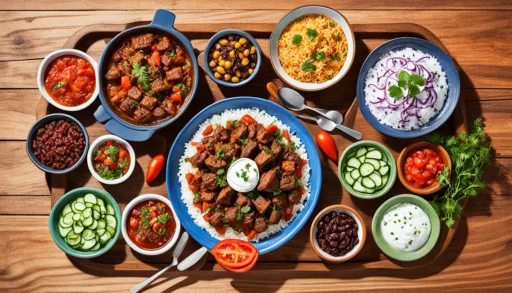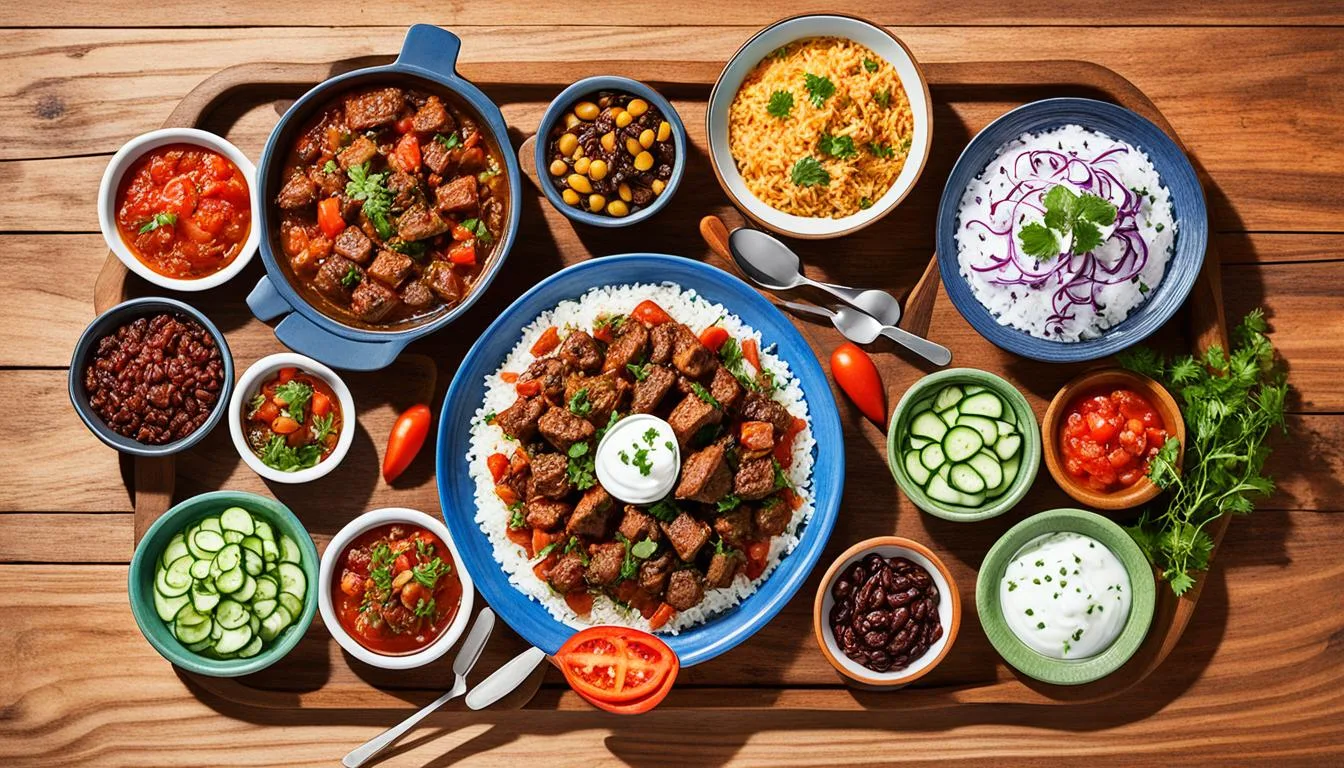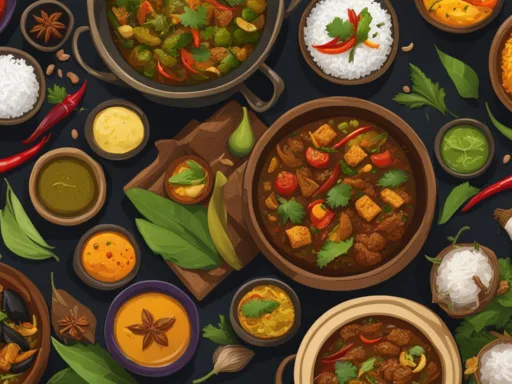Despite its modest geographical size, the small nation of Djibouti holds an astounding culinary diversity that has evolved from a melting pot of cultures and traditions. Nestled in the Horn of Africa, Djibouti bridges the tastes of East Africa with the aromatic essences of the Middle East and the intricate flavors of South Asia. Embarking on a journey through the country’s cuisine, your palate will be treated to an array of dishes that promise to challenge assumptions and delight, with every bite offering a new discovery. This is your ultimate Djiboutian Culinary Guide to the authentic Djiboutian cuisine and the vibrant local food in Djibouti.
Key Takeaways
- Discover Djibouti’s unique combination of African, Middle Eastern, and South Asian culinary influences.
- Explore traditional breads like lahoh and injera, essential carriers for the country’s rich stews.
- Gain insight into the importance of seafood and meats in Djibouti’s gastronomic traditions.
- Learn about the communal nature of Djiboutian meals, embodying the spirit of unity.
- Find out how Djibouti’s strategic trade route location has created a unique blend of flavors.
- Deepen your understanding of the cultural significance behind festive dishes like Hambal.
- Prepare to be captivated by the story each dish tells of Djibouti’s past and present.
Exploring the Essence of Djiboutian Cuisine
The flavorful mosaic of Djibouti food culture represents a confluence of regional culinary arts, painting a picture of the nation’s rich history and diverse heritage. As you embark on a Djiboutian cuisine exploration, you uncover a world where traditional recipes and contemporary practices coexist, offering a unique taste experience that continues to evolve while remaining true to its roots.
https://www.youtube.com/watch?v=8Saflmxh2Ns
Blend of African, Arabic, and Indian Influences
Traditional Djiboutian dishes are a testament to the cultural crossroads of Africa, the Middle East, and South Asia. Culinary enthusiasts revel in the harmony of flavors and techniques that define such beloved dishes as the fragrant Skoudehkaris, the pillowy softness of Lahoh, and the sumptuous Maraq Fahfah. These staples owe their essence to the spices that are quintessential to the region—cumin, cardamom, and cloves—each adding a layer of complexity and depth to the cuisine.
Nomadic Traditions and Coastal Flavors
Popular dishes in Djibouti often reflect the country’s pastoral nomadic lifestyle, offering a gastronomic narrative of the people’s adaptive strategies and resourcefulness. Ingredients from the bountiful coast, paired with the inland harvests, create a diverse palate of flavors. For instance, the hearty stew Skoudehkaris connects the sea and the land, presenting a dish equally enjoyed by communities from all corners of Djibouti.
The Role of Spices and Staples in Djibouti’s Culinary Culture
In Djibouti’s culinary landscape, spices hold a place of honor, used not merely as seasoning, but as cultural signifiers that bridge generations and geographical divides. Equally important to the culinary experience are the staples, particularly the various breads like Canjeero and Injera, which are at the heart of every meal. As vehicles for savoring the rich stews and dips, these breads encapsulate the spirit of Djiboutian cuisine, encompassing tradition and the shared joy of communal dining.
Skoudehkaris: The National Dish of Djibouti
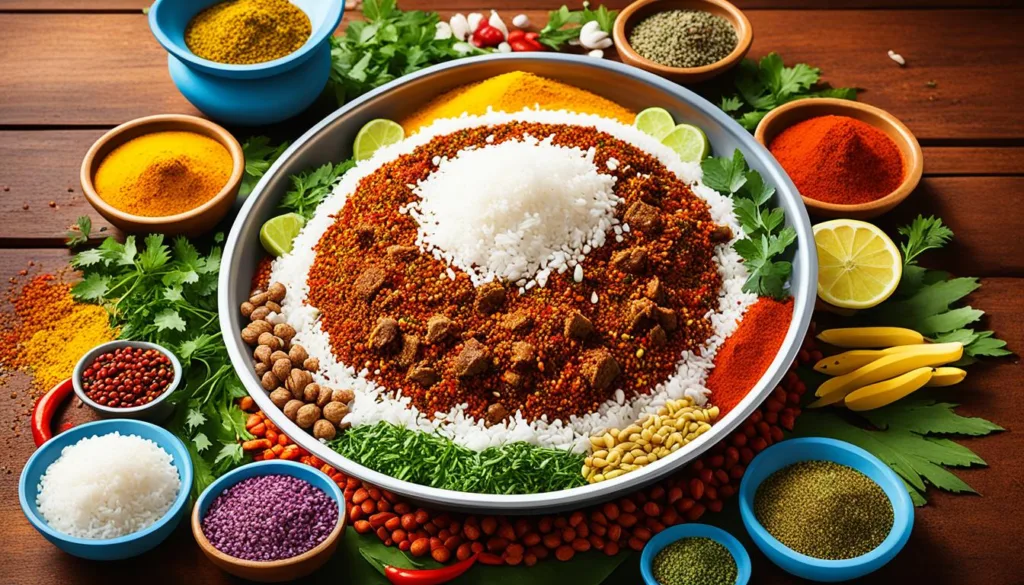
Among the best Djiboutian recipes, Skoudehkaris stands out as a cultural icon that unites the taste buds of a nation. This beloved national dish goes beyond mere sustenance; it’s a flavorful narrative of Djibouti’s history, embodying the spirit of Djiboutian culinary traditions. Imagine a pot simmering gently over an open flame, with a blend of spices such as cumin, coriander, and cardamom wafting through the air, as tender lamb or goat meat mingles with basal rice to create a harmony of flavors. It’s more than a meal; it’s a symbol of communal belonging and joy.
In its most traditional form, Skoudehkaris is not only a feast for the senses but a celebration of community. At weddings, festivals, and family gatherings, people come together to share this dish, reinforcing the ties that bond them. The simple act of sharing a single pot of Skoudehkaris exemplifies the spirit of generosity and togetherness that is a cornerstone of life in Djibouti.
While lamb or goat are most commonly used, the coastal influence of Djibouti allows for delightful variations, incorporating chicken or fish. It’s the kind of dish that allows for adaptation while still retaining the core elements that make it distinctively Djiboutian. This versatility speaks to the adaptability and ingenuity of the people, who have embraced their geographical and cultural richness to produce some of the best Djiboutian recipes known today.
“Skoudehkaris is not just about the fusion of spices and ingredients; it’s about the fusion of people, traditions, and histories. It’s a dish that truly represents the heart of Djibouti.”
- Prepared using a one-pot method, ensuring a deeply infused flavor.
- Typically served with a fresh salad or cooling yogurt accompaniment.
- Embraced during significant family events and communal celebrations.
- Represents Djibouti’s resilience and adaptability as a nation.
Whether enjoyed in a humble village home or at a bustling city celebration, Skoudehkaris is a taste of Djibouti that transcends social and economic boundaries, offering a heartfelt welcome to anyone seated at the table. Through such dishes, the essence of Djiboutian hospitality is expressed, inviting everyone to partake in the warmth and conviviality of its people. When it comes to Djiboutian culinary traditions, one needs to look no further than a steaming plate of Skoudehkaris to understand the culinary heart of this captivating country.
Time-Honored Cooking Techniques in Djiboutian Cuisine
The fabric of Authentic Djiboutian cuisine is interwoven with cooking practices steeped in tradition. Hidden within the subtle maneuvers of seasoned hands are the rich tapestries of history and culture, influential in crafting every bite of Traditional Djiboutian dishes. From sunrise to sunset, these methods are the pillars of a gastronomic legacy, dedicating homage to the age-old wisdom of Djiboutian ancestors. This section of the Djiboutian Culinary Guide will delve into the culinary finesse behind the breakfast favorite Canjeero and the intricacies involved in preparing delectable stews that are the pride of Djibouti.
The use of the Traditional Canjeero
Canjeero, with its soft, spongy texture and subtle tang, begins its journey in the twilight before dawn, resulting in a breakfast that resonates with generations of Djiboutian family tables. The process of fermenting the batter, similar to the crafting of South India’s famed dosas, is a testament to patience and technique. Relished for its versatility, Canjeero is savored alongside dollops of ghee, a drizzle of honey, or dipped into a piquant sauce, igniting the day with a taste of Djiboutian zest.
Preparation of Skoudehkaris and Maraq Fahfah
Skoudehkaris, a dish that has traversed through time to become a symbol of unity, relies on gentle simmering techniques; the rice slowly caresses the aromatic blend of spices and tender meat, ensuring each grain is imbued with flavor. Maraq Fahfah’s soul, a stew with layers of aromatic herbs and spices, takes form under the watchful eye of a slow burn, allowing its components to meld into a savory embrace that warms the heart of Djiboutian cuisine. Both dishes bear the hallmark of Djiboutian culinary tradition — a confluence of care, communal spirit, and the handed-down wisdom of predecessors.
To showcase the comparative elements of these time-honored cooking techniques, observe the following table which captures the essence of what it takes to create these gastronomic delights:
| Dish | Key Ingredients | Cooking Technique | Associated Mealtime |
|---|---|---|---|
| Canjeero | Fermented flour, ghee, honey | Griddled fermentation | Breakfast |
| Skoudehkaris | Rice, lamb/goat meat, spices | Simmering for flavor absorption | Lunch/Dinner |
| Maraq Fahfah | Vegetables, meat, aromatic spices | Low and slow stewing | Dinner |
As we appreciate the elaborate process behind each meal, from the first crack of dawn to the setting sun, we recognize the true essence of Djiboutian Culinary Guide. It stands as a testament to an unwavering commitment to maintain the authenticity ingrained within these delicious culinary traditions—a journey through taste and time.
Sampling the Array of Flavors in Djibouti’s Culinary Repertoire
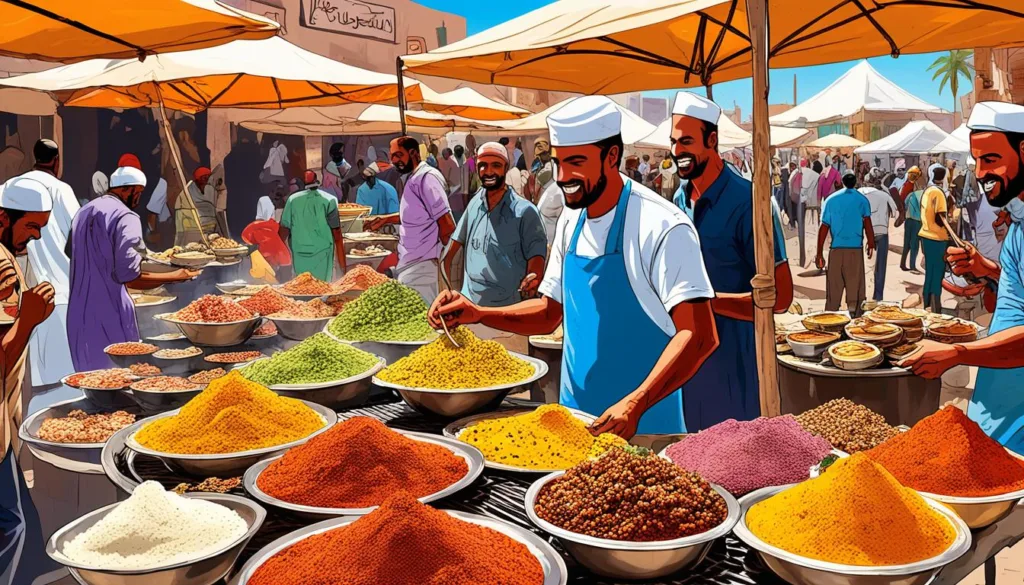
Dive into Djiboutian cuisine exploration and discover the flavors that make popular dishes in Djibouti a tapestry of tastes to delight food enthusiasts. Each recipe offers an insight into the nation’s eclectic culinary narrative, promising to satisfy a variety of palates and preferences.
Take for instance the ubiquitously savored lahoh. This spongy, pancake-like bread serves as a perfect companion to a plethora of meat or vegetable sauces, showcasing its versatility within the culinary tradition. Then there is Maraq Buuro, a testament to the local love of hearty soups, often made with the robust flavors of camel meat. This dish offers both warmth and nourishing satisfaction.
For those who delight in the kick of spices paired with the richness of meat, Cambaboor is an essential dish in the Djiboutian food anthology. A combination of ground meat and lentils, Cambaboor illustrates the skillful incorporation of spices that are essential to the creation of some of the best Djiboutian recipes.
Seafood, freshly caught from the Indian Ocean, presents another facet of the nation’s gastronomy. Whether grilled to perfection or stewed in a flavorful broth, it represents Djibouti’s utilization of its natural seafood resources.
As you journey through Djibouti’s diverse culinary landscape, each dish not only tantalizes the taste buds but also speaks volumes about the local culture and traditions. Below is a snapshot of a few culinary highlights:
- Lahoh – A staple spongy bread for dipping and scooping.
- Maraq Buuro – A flavorful camel meat soup embodying comfort.
- Cambaboor – A spiced, ground meat and lentil feast for the senses.
- Seafood Specialties – Grilled or stewed selections showcasing the freshest ocean flavors.
Engage in the vibrant array of textures and tastes with a preparedness to be swept away by the authentic and unforgettable Djiboutian cuisine exploration. Every morsel embodies a story, each bite an experience, making Djibouti a compelling culinary destination.
Beyond the Main Course: Sides and Sweets in Djibouti
The exploration of Djiboutian culinary traditions offers a banquet of flavors that extend beyond the main attractions to include a rich assortment of sides and sweets. These traditional Djiboutian dishes play a significant role in the dining experience, showcasing the gastronomic diversity of this East African nation.
Savory Lahoh and Spongy Injera
As staples in Djiboutian cuisine, lahoh and injera are more than mere sides. Lahoh, with its mildly tangy profile, serves as an excellent base for the rich stews it accompanies. This spongy, fermented bread exemplifies the shared culinary practices within the Horn of Africa. Injera, equally pivotal, acts almost as a utensil, allowing diners to pick up other foods and absorb sauces, enriching every meal with its soft, porous texture.
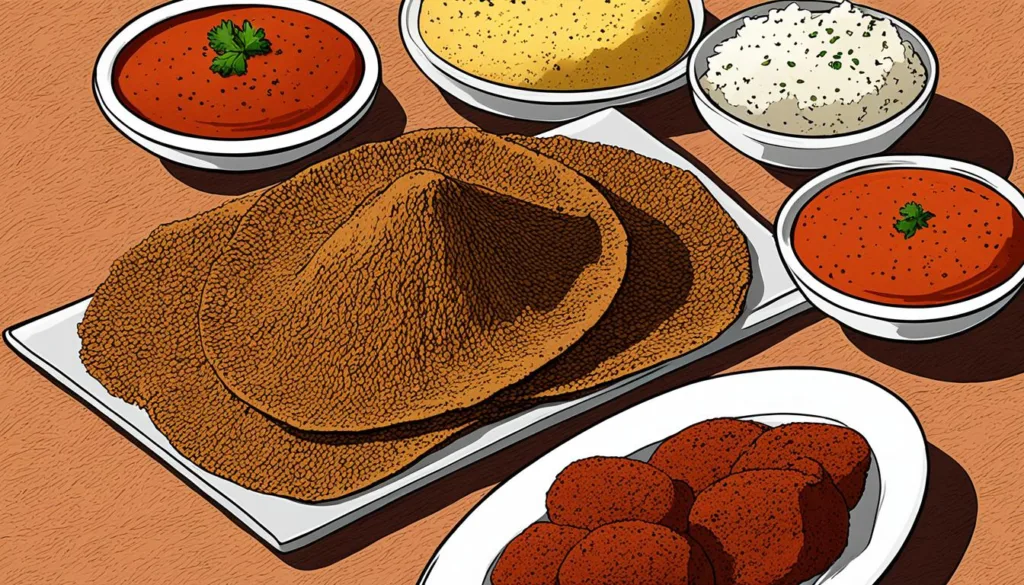
Sweet Delicacies: Xalwo and Other Treats
The sweetness of Djiboutian cuisine shines through in treats like Xalwo (halva), a confection that tantalizes palates at celebrations and is a mark of true Djiboutian hospitality. Its sticky texture and infusion of traditional spices like cardamom create a dessert that’s as rich in flavors as it is in cultural significance. This dessert, among others, represents the warmth and sweetness of Djiboutian celebrations.
Djiboutian Culinary Guide
Embarking on an authentic Djiboutian cuisine exploration is as much an adventure for the palate as it is a cultural expedition. To truly indulge in the local food in Djibouti, one must dive into the vibrant markets and welcoming eateries where traditional recipes come alive.
Finding Authentic Djiboutian Cuisine
There’s no better way to experience the heart of Djiboutian culinary mastery than by seeking out the places locals cherish. Whether it is a humble street-side stall or a family-run restaurant, these havens of gastronomy serve as gatekeepers of traditional tastes and culinary craftsmanship.
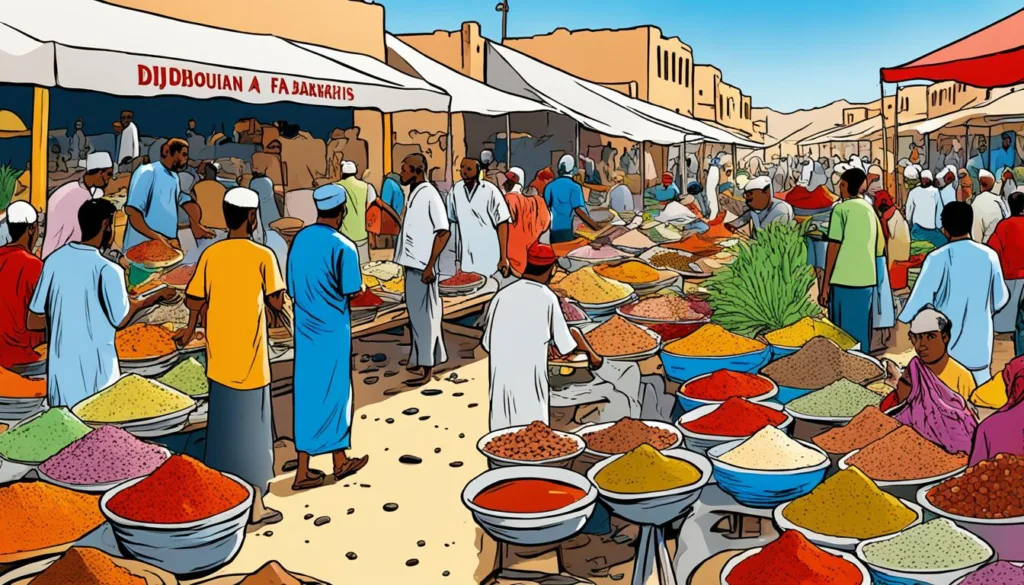
Navigating Local Markets for Ingredients
For those eager to recreate the magic of Djiboutian dishes in their own kitchens, navigating the bustling local markets is a must. Here, one can uncover the freshest produce and aromatic spices essential to carving out the rich, bold flavors signature to the region. Engaging with vendors not only secures the key components of classic dishes but also provides an immersive cultural experience.
- Explore stalls brimming with ripe vegetables and fruits
- Select from an array of local meats, ranging from lamb to camel
- Discover the blend of spices that gives each dish its unique identity
- Gain insights from local vendors and fellow shoppers
A Djiboutian Culinary Guide isn’t complete without the essential knowledge of where and how to find the building blocks of the country’s storied recipes. As you weave through the maze of colors, flavors, and aromas, each step brings you closer to mastering the art of local Djiboutian cuisine.
Cultural Insights: Dietary Practices and Eating Habits in Djibouti
The culinary landscape of Djibouti provides an insightful reflection into the local customs and traditions. Central to understanding Djibouti food culture are the valued norms around communal dining and the impacts of religious observances on daily meals.
Communal Meals and Their Significance
Communal meals serve as the cornerstone of Djibouti’s dining experience, embodying the tight-knit fabric of society. Across the country, families and friends gather to share traditional Djiboutian dishes, rooting their relationships in the very act of breaking bread together. Whether it’s enjoying the best Djiboutian recipes at home or gathering at local eateries, these meals go beyond nutrition—they are a celebration of collective identity and heritage.
Take, for instance, the prevalent dish Skoudehkaris, a sociable affair often serving as the centerpiece at these gatherings. The preparation and consumption of this popular dish in Djibouti not only pleases the palate but also fortifies social bonds.
Religious Influences and Fasting Periods
Religion exerts a profound influence on the eating habits of Djiboutians, with the majority following Islamic dietary laws. Particularly during the holy month of Ramadan, the rhythms of daily life are attuned to the cycles of fasting and feasting. Fasting from dawn to dusk, the iftar meals feature traditional Djiboutian dishes, underscored by a sense of communal spirit and gratitude.
The preparation of food during these periods is permeated with care and intention, with an emphasis on sharing and giving – values deeply rooted in Djibouti food culture. The conclusion of fasting brings about a festive spirit, and the culinary practices reflect this in the variety of rich, celebratory foods that grace the table.
A Gourmet Tour of Djibouti City’s Food Scene
Djiboutian cuisine exploration is an adventure for the senses, and nowhere is this truer than in the bustling food scene of Djibouti City. As you wander through the city’s streets, the array of Local food in Djibouti invites you to experience the rich tapestry of tastes and aromas that are hallmarks of this vibrant city. From the aromatic sizzle of street food vendors to the understated elegance of fine dining establishments, each offers a window into the soul of Popular dishes in Djibouti.
Embark on a culinary journey through the city’s eateries, each with its distinctive flair. The humble flatbread malawah, with its soft texture and rich flavor, is a local favorite often enjoyed for breakfast or as a snack. As the sun sets, the city’s array of restaurants come to life, serving hearty stews that speak to the traditional fare of the region.
- Street Food Stalls – Dive into the heart of Djibouti’s street food; savour grilled meats and freshly baked breads right off the griddle.
- Seafood Delights – With the Indian Ocean at its doorstep, savor the fresh catch of the day served in a variety of styles from grilled to curried.
- Traditional Eateries – Explore the rich depth of Djiboutian stews and biryanis, each a testament to the country’s culinary heritage.
Djibouti City serves not just a meal, but an entire experience that transcends the realm of the plate. It is a celebration of community, a reflection of the city’s diverse influences, and a delicious display of creativity in the kitchen. A gourmet tour through this city is an essential foray for anyone looking to feed their culinary curiosity with the authentic essence of Djiboutian cuisine.
The Role of Festive Foods and Celebratory Meals in Djibouti
In the heart of the Horn of Africa, Djibouti stands out not just for its strategic location but also for its rich culinary traditions. Here, traditional Djiboutian dishes are not mere sustenance; they are a celebration of life’s pivotal moments. Celebratory meals play an essential role in marking the vibrant and joyous occasions that shape Djiboutian culture.
Festivities in Djibouti are incomplete without the presence of communal feasts that showcase the best Djiboutian recipes. These dishes, passed down from generation to generation, are central to any celebration and are cherished for their ability to bring people together in a shared experience of dining and socializing.
Special Occasion Dishes
Unique and flavorful, special occasion dishes are the highlight of Djiboutian festivities. A wedding, a birth, or even national holidays are often graced by the renowned dish Hambal, a flavorful combination of rice and tender meat that symbolizes unity and prosperity. This dish, among others, is a testament to the rich culinary diversity and the intricate cooking techniques mastered over the centuries.
Feasting and Hospitality: A Djiboutian Tradition
Djiboutian hospitality is legendary, and it shines brightest during celebrations where the philosophy is one of abundance. Hosts take pride in preparing lavish spreads that often feature the national dish Skoudehkaris, a reflection of the generosity and warmth that is inherent to Djiboutian culture. Feasts are not just meals but ceremonial acts that strengthen community ties and reaffirm cultural identity.
| Occasion | Main Dish | Significance |
|---|---|---|
| Weddings | Hambal | Unity of families and celebration of new beginnings |
| National Festivals | Skoudehkaris | Cultural pride and national identity |
| Birth Celebrations | Fah-fah | Wishes for health and prosperity |
| Religious Holidays | Maraq Fahfah | Spiritual reflection and community cohesion |
Embracing the rich and fragrant world of Djiboutian culinary traditions is a journey through time and taste. Celebratory meals serve as much more than a showcase for traditional Djiboutian dishes; they are a vibrant expression of joy and community spirit, ensuring that each bite taken is a story of Djibouti itself.
Conclusion
As we draw the curtains on this delectable journey through Djibouti’s culinary wonders, our palates are rich with flavors that have danced across our tongues. The Djiboutian Culinary Guide has led us through narrow market lanes bursting with spices, into the kitchens where Authentic Djiboutian cuisine is crafted with love and served with open arms. From the umami-laden Skoudehkaris to the sweetness of Xalwo, each dish has narrated a part of Djibouti’s soul, proving why these are some of the Best Djiboutian recipes.
Throughout this gastronomic voyage, we have savored more than just food; we have consumed history and culture with every bite. The cuisine here is not merely about sustenance but about reiterating a confluence of African, Arabic, and Indian influences that crescendo in Djibouti’s landscape of diverse tastes. It’s about upholding traditions while celebrating community through meals that are both a testament to the past and a toast to the present.
Our expedition through Djibouti’s flavors implores every food enthusiast to venture into this corner of the world, where the tapestry of taste is as rich as the hospitality of its people. In taste, we find connection, and with each shared meal, we weave ourselves into the fabric of Djiboutian life. Embark on this Authentic Djiboutian culinary adventure to not just eat, but to feel and live the vibrant spirit of Djibouti. Bon Appétit!
